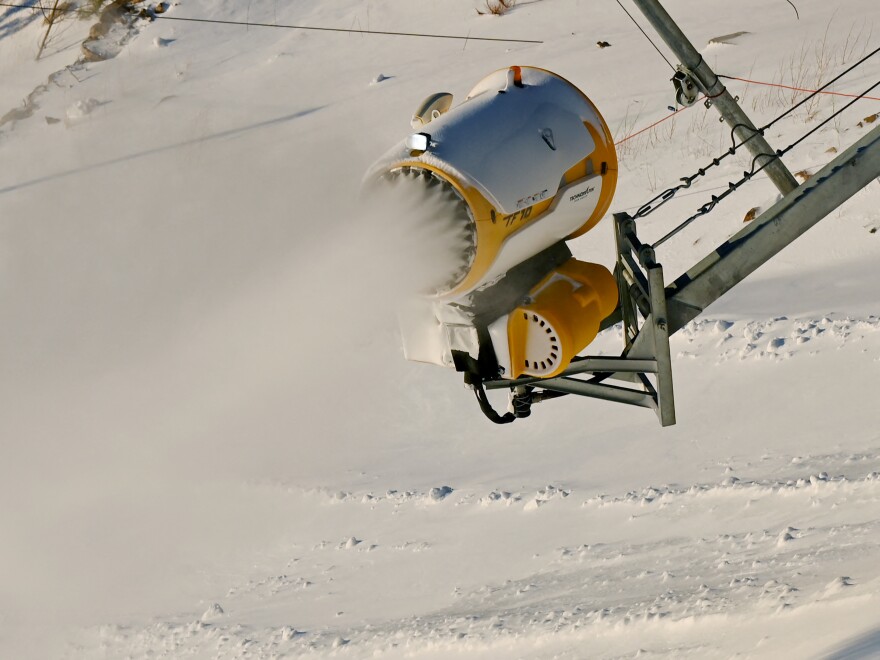BEIJING — The bright, white Yanqing ski course northwest of Beijing sticks out on the brown and dry landscape of the surrounding Xiaohaituo Mountain.
The venue was the site of highly anticipated men's and women's downhill ski events at the Beijing Winter Games on Monday. Underneath each of these top-tier athletes' skis was almost entirely artificial snow.
Though temperatures at this Olympic venue are downright frigid, real snow is not easy to come by.
"Where can you go to get minus 15 (degrees Celsius) and sun and no snow coming for a week?" Norwegian alpine skier Kjetil Jansrud said of the venue.
As the climate warms, experts in winter sports say the use of fake snow in athletic competitions is the new reality. Natural snow hasn't been a reliable option for professional ski and snowboarding competitions for some time — and that includes at the Winter Olympic Games.
Human-made snow is likely going to be at all future Olympic alpine events, according to Bernhard Russi, the chairman of the International Ski Federation's alpine committee.
"This is nothing new. Already in the past, I would say five to 10 years, we have been skiing only on man-made snow," Russi said during a news conference.
Host cities of earlier Winter Games relied on, to some degree, fake snow. The 2018 Pyeongchang Olympics had similarly dry, yet frigid temperatures as Beijing. Other hosts, Sochi and Vancouver, also deployed artificial snow on mountain ranges due to unseasonably warmer weather.
How Beijing made it snow
Placing ski and snowboarding venues in regularly dry climates turned out to be a small obstacle for Olympics organizers. With the right technology, the perfect ski conditions are just a button away.
The snow-making process began back in November, and continued for seven weeks, according to Wei Qinghua. He is the mountain operation manager at the Zhangjiakou and Guyangshu Olympic venues.
The machine used during the 2022 Winter Games allows technicians to choose different types of snow to factor in what's needed for each sport.
"The smaller the number, the lighter the snow," said Wei.
Cross-country skiing and biathlon requires No. 3 snow, Wei said. For the ski jumping center, organizers used the No. 5 snow, which can be adjusted perfectly for the 33.6-degree slope for the athletes.

Course managers can also control the humidity, temperature and other factors to make the ideal snowfall.
According to the rules, new snow can't be added during the competitions. That's because newly made snow has a different quality from older snow, Wei said Monday.
At night, operators tackle snow upkeep.
"We will maintain and compact the snow at night, according to the schedule of competition. It usually takes five hours," he said.
Using artificial snow requires large amounts of water and the use of chemicals — the health and environmental impact of which is still largely unknown.
But Wei defended the use of machine-made snow during the 2022 Games.
He said the source of water for the Guyangshu snow "only comes from rainfall and also the surface runoff." The water used during the Games "can be recycled" for other purposes such as agricultural irrigation, tourism and landscaping.
Using any natural snow was also just not realistic for the ski jumping events in Zhangjiakou, Wei said. That event requires a specific height for the landing hill for jumpers.
"Therefore, we have to very carefully control the amount of snow by using the artificial snow-making technology," he said.
Athletes give top marks

At the Yanqing site, a casual observer wouldn't know the difference between the natural white stuff and the artificially made snow. It's all the same — white, cold and icy.
Professional athletes can feel the difference, though.
Ahead of training, U.S. alpine skier AJ Hurt, who competed Monday, was a bit concerned about the snow quality.
"Coming into it I think we were a little bit concerned. We were like 'Oh, it's never snowed here before, or it doesn't snow here often, it's all man-made snow,'" she said days before her competition.
James Clugnet, a cross-country skier from Great Britain, told reporters he wasn't a fan.
"The course is super, super slow," Clugnet said. "It's so cold, and it's a bit like a desert next to the track, so when it's windy, the sand comes into the track. You have to reach a certain speed and then you're all right, but when you're going slowly, it feels like you're standing still."
Overall, most skiers and snowboarders appeared to find the course in the right condition for their competitions.
Once out on the slopes, Hurt said her worries were unfounded.
"The snow surface is perfect really," she said.
Copyright 2022 NPR. To see more, visit https://www.npr.org.





